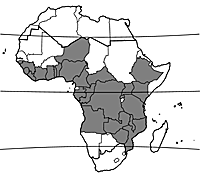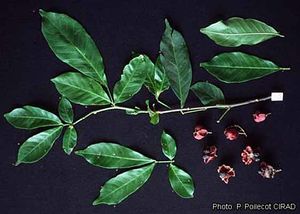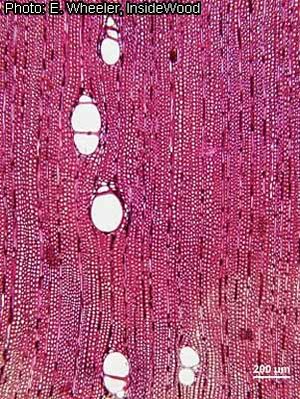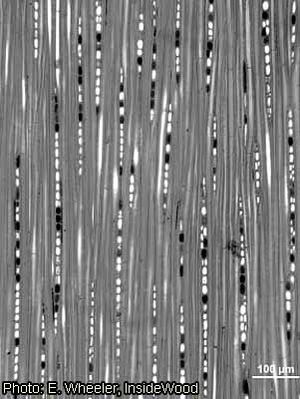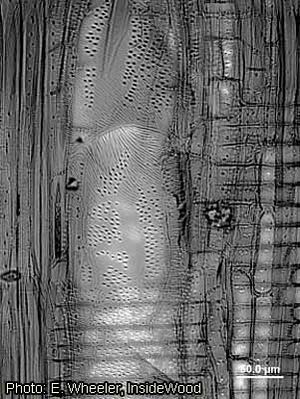Blighia unijugata (PROTA)
Introduction |
| General importance | |
| Geographic coverage Africa | |
| Geographic coverage World | |
| Carbohydrate / starch | |
| Essential oil / exudate | |
| Medicinal | |
| Timber | |
| Fuel | |
| Ornamental | |
| Auxiliary plant | |
Blighia unijugata Baker
- Protologue: Oliv., Fl. trop. Afr. 1: 427 (1868).
- Family: Sapindaceae
- Chromosome number: 2n = 32
Vernacular names
- Triangle tops (En).
- Mwakamwatu, mkivule (Sw).
Origin and geographic distribution
Blighia unijugata is widespread in tropical Africa, extending from Guinea Bissau eastwards to Ethiopia and Kenya, and through DR Congo southwards to Angola, Zimbabwe and Mozambique. It is also found in South Africa.
Uses
The wood of Blighia unijugata is commonly used for light construction, light flooring, interior trim, joinery, furniture, mine props, toys, novelties, agricultural implements, musical instruments, boxes, crates, turnery and carving. It is suitable for ship building, veneer, plywood and pulpwood. It is also used as firewood and for charcoal production.
The leaves are eaten as a vegetable in Nigeria. Various parts of the tree are considered to have sedative and analgesic properties. They are used in traditional medicine for the treatment of rheumatism, kidney pain and stiffness, and they are reputed to have oxytocic action in childbirth. Bark pulp is applied as an enema or a bark decoction is taken to treat fever, and as purgative. In Côte d’Ivoire leaf pulp is administered as an embrocation to serve as rejuvenant and relaxant. In Congo the leaves are used in vapour baths for the treatment of fever in children, and as tonic. Fruits have been used in Nigeria for the treatment of nausea and vomiting. In the Central African Republic seed oil is used in medicinal ointments and a leaf decoction to treat vertigo. Macerated twigs, leaves, flowers and fruits are used as fish poison. In Sierra Leone the seeds are reported to be edible. In South Africa the pleasantly scented flowers are sometimes soaked in water to make a fragrant cosmetic lotion.
Blighia unijugata is commonly planted as a village shade tree. In Kenya and Ethiopia, the trees are often left after land clearance or sometimes planted to provide shade in coffee plantations. The flowers provide nectar and pollen for honey bees.
Production and international trade
The wood of Blighia unijugata is used locally and only occasionally traded on the international market.
Properties
The heartwood is pale reddish brown and indistinctly demarcated from the yellowish white sapwood. The grain is fairly straight, texture medium to fine.
The wood is medium-weight, with a density of 560–640 kg/m³ at 12% moisture content, and fairly hard. It air dries slowly but usually well with little degrade. However, the shrinkage rates are quite high, from green to oven dry 5.1% radial and 8.1% tangential. At 12% moisture content, the modulus of rupture is 92 N/mm², modulus of elasticity 11,170 N/mm², compression parallel to grain 49 N/mm² and shear 15.5 N/mm².
The wood works well with machine tools, but blunting of tools is rather rapid. It is difficult to work by hand, but takes a good finish and polishes well. Splitting is common during nailing and pre-boring is recommended. It is also recommended to give good support at the exit face on mortising and boring. The wood is somewhat difficult to glue. The heartwood is moderately durable, but the sapwood is susceptible to Lyctus attack. The heartwood is moderately resistant to preservative treatment, the sapwood is permeable.
Tests in Nigeria showed an oil yield of 51% in the aril and 14% in the seed. The composition of the aril is: water 3.3%, protein 20%, fat 51%, carbohydrate 9% and fibre 11%; and of the seed: water 6.1%, protein 14%, fat 14%, carbohydrate 54% and fibre 6%. The oils from arils and seeds were found to be rich in macronutrients and appear to be a good source of minerals. Triacylglycerol is the dominant lipid compound in the oils, with 88% and 91% respectively for aril and seed.
Ethanol extracts of roots, bark and leaves showed antibacterial activity, with pronounced activity against Staphylococcus aureus. In all the extracts the presence of steroids, saponins and tannins has been demonstrated.
Description
- Dioecious, small to medium-sized tree up to 30(–35) m tall; bole often quite short, usually straight, up to 180(–200) cm in diameter, slightly fluted at base; bark surface fairly smooth, but often with horizontal ridges and warts, grey to dark green, inner bark thin, brittle, granular, white to pale red or brown with white streaks; crown dense and rounded; young twigs finely orange-brown hairy, becoming glabrous.
- Leaves alternate, paripinnately compound with (1–)2–4(–5) pairs of leaflets; stipules absent; petiole up to 4 cm long, flattened above, rachis up to 10 cm long; petiolules up to 2 mm long; leaflets opposite, elliptical to oblong or obovate, up to 30 cm × 13 cm but often small in lowest pair, cuneate to obtuse at base, acuminate at apex, margins entire or slightly wavy, glabrous except for tufts in the axils of lateral veins, pinkish red or whitish when young, later becoming glossy dark green above and dull green below, pinnately veined with 6–10(–12) pairs of prominent lateral veins.
- Inflorescence an axillary false raceme up to 10 cm long.
- Flowers unisexual, regular, 5-merous, whitish or yellowish, sweet-scented; pedicel up to 5 mm long, elongating up to 10 mm in fruit; calyx with tube about as long as lobes, c. 2 mm long; petals free, rhomboid, c. 2 mm × 2 mm, hairy, with a 2-lobed scale on the inner face; stamens 6–10, free, filaments c. 4 mm long, hairy in lower part; ovary superior, golden-hairy, usually 3-lobed and 3-celled, style short; male flowers with rudimentary ovary, female flowers with reduced stamens.
- Fruit a top-shaped, usually 3-gonous capsule 2–3 cm × 2.5–3 cm, pointed at apex, red when ripe, slightly hairy, dehiscing with 3 woody recurving valves pink inside with yellow margins, usually 3-seeded.
- Seeds ovoid, 1–2 cm long, glossy dark brown to black, with yellow cup-shaped aril up to 1 cm long at base.
- Seedling with hypogeal germination; epicotyl c. 6 cm long, hairy; first 2 leaves opposite, with 3 obovate leaflets up to 4 cm × 2 cm.
Other botanical information
Blighia comprises 3 species and is restricted to tropical Africa. Blighia unijugata can be distinguished from the other two species by its leaflets having tufts of hairs in the axils of lateral veins and its fruits which are up to 3 cm long (at least 4 cm long in the other species).
Anatomy
Wood-anatomical description (IAWA hardwood codes):
- Growth rings: 1: growth ring boundaries distinct.
- Vessels: 5: wood diffuse-porous; 13: simple perforation plates; 22: intervessel pits alternate; (23: shape of alternate pits polygonal); 25: intervessel pits small (4–7 μm); 30: vessel-ray pits with distinct borders; similar to intervessel pits in size and shape throughout the ray cell; 42: mean tangential diameter of vessel lumina 100–200 μm; 46: ≤ 5 vessels per square millimetre; 47: 5–20 vessels per square millimetre; 58: gums and other deposits in heartwood vessels.
- Tracheids and fibres: 61: fibres with simple to minutely bordered pits; 65: septate fibres present; (66: non-septate fibres present); 69: fibres thin- to thick-walled.
- Axial parenchyma: 75: axial parenchyma absent or extremely rare; 78: axial parenchyma scanty paratracheal; (92: four (3–4) cells per parenchyma strand); 93: eight (5–8) cells per parenchyma strand.
- Rays: 96: rays exclusively uniseriate; (97: ray width 1–3 cells); (100: rays with multiseriate portion(s) as wide as uniseriate portions); 104: all ray cells procumbent; 115: 4–12 rays per mm; 116: ≥ 12 rays per mm.
- Mineral inclusions: 136: prismatic crystals present; 138: prismatic crystals in procumbent ray cells.
Growth and development
In general, Blighia unijugata is considered to grow rapidly. The tree is attractive, with its decoratively coloured new leaves and red fruits. In Ghana and Nigeria, flowering is from December to April and ripe fruit is found around March. In Côte d’Ivoire trees have been reported to flower twice a year, January–April and September–October; ripe fruits have been recorded in March and October. In southern Africa flowering occurs from September to October and fruits are found from September to February. The flowers attract large numbers of flies, which probably serve as pollinators. The seeds with their yellow aril are eaten by birds, duikers, monkeys such as mangabeys, and chimpanzees, which may be important seed dispersers.
Ecology
Blighia unijugata occurs mostly in moist evergreen forest, but also in semi-deciduous forest, in more dry areas in riverine forest, and in wooded grassland and then often associated with termite mounds, up to 1900 m altitude.
Propagation and planting
Natural regeneration of Blighia unijugata usually occurs in disturbed forest. For planting, it is propagated by seeds and wildlings. Seeds germinate readily. It is recommended to sow in pots before transplanting. Pretreatment of seeds before sowing is not necessary. Dried seeds can be stored for considerable time in sealed containers in a cool and dry place. Thin stem cuttings may root in sand and can also be used for propagation.
Management
Blighia unijugata can be managed by coppicing and pollarding.
Diseases and pests
The larvae of the butterfly gold-banded forester (Euphaedra neophron) are reported to feed on leaves of Blighia unijugata in Mozambique. In Tanzania infestation by the parasitic plant Tapinanthus bangwensis (Engl. & K.Krause) Danser has been recorded as locally problematic in plantations of Blighia unijugata mixed with other tree species.
Genetic resources
Blighia unijugata is widespread and in many regions within its geographical range common. It is unlikely that it suffers from genetic erosion. However, in several countries in southern Africa, e.g. Zambia and South Africa, it is uncommon.
Prospects
Blighia unijugata is a useful local source of wood and traditional medicine. Although little is known about growth rates, it seems to be a fast growing tree and is considered suitable for commercial plantations. It is promising for planting in agroforestry systems. Further research is warranted on the potentials of the seeds, which could be considered for use as feed supplements and in the food industry.
Major references
- Ayodele, R.O., Ajayi, I.A. & Adewuyi, A., 2008. Nutritional elements, antibacterial activity and cytotoxicity of the leaf, root and stem bark of Blighia unijugata Baker (Sapindaceae). Medicinal and Aromatic Plant Science and Biotechnology 2(2): 137–140.
- Bekele-Tesemma, A., 2007. Useful trees and shrubs for Ethiopia: identification, propagation and management for 17 agroclimatic zones. Technical Manual No 6. RELMA in ICRAF Project, Nairobi, Kenya. 552 pp.
- Burkill, H.M., 2000. The useful plants of West Tropical Africa. 2nd Edition. Volume 5, Families S–Z, Addenda. Royal Botanic Gardens, Kew, Richmond, United Kingdom. 686 pp.
- Chikamai, B.N., Githiomi, J.K., Gachathi, F.N. & Njenga, M.G., undated. Commercial timber resources of Kenya. Kenya Forestry Research Institute (KEFRI), Nairobi, Kenya. 164 pp.
- Davies, F.G. & Verdcourt, B., 1998. Sapindaceae. In: Beentje, H.J. (Editor). Flora of Tropical East Africa. A.A. Balkema, Rotterdam, Netherlands. 108 pp.
- Katende, A.B., Birnie, A. & Tengnäs, B., 1995. Useful trees and shrubs for Uganda: identification, propagation and management for agricultural and pastoral communities. Technical Handbook 10. Regional Soil Conservation Unit, Nairobi, Kenya. 710 pp.
- Maundu, P. & Tengnäs, B. (Editors), 2005. Useful trees and shrubs for Kenya. World Agroforestry Centre - East and Central Africa Regional Programme (ICRAF-ECA), Technical Handbook 35, Nairobi, Kenya. 484 pp.
- Neuwinger, H.D., 2000. African traditional medicine: a dictionary of plant use and applications. Medpharm Scientific, Stuttgart, Germany. 589 pp.
- Widodo, S.H., 2001. Crescentia L. In: van Valkenburg, J.L.C.H. & Bunyapraphatsara, N. (Editors). Plant Resources of South-East Asia No 12(2): Medicinal and poisonous plants 2. Backhuys Publishers, Leiden, Netherlands. pp. 191–194.
Other references
- Aubréville, A., 1959. La flore forestière de la Côte d’Ivoire. Deuxième édition révisée. Tome troisième. Publication No 15. Centre Technique Forestier Tropical, Nogent-sur-Marne, France. 334 pp.
- Coates Palgrave, K., 1983. Trees of southern Africa. 2nd Edition. Struik Publishers, Cape Town, South Africa. 959 pp.
- Exell, A.W., 1966. Sapindaceae. In: Exell, A.W., Fernandes, A. & Wild, H. (Editors). Flora Zambesiaca. Volume 2, part 2. Crown Agents for Oversea Governments and Administrations, London, United Kingdom. pp. 494–543.
- Fowden, L., Macgibbon, C.M., Mellon, F.A. & Sheppard, R.C., 1972. Newly characterized amino acids from Blighia unijugata. Phytochemisty 11: 1105–1110.
- Hauman, L., 1960. Sapindaceae. In: Robyns, W., Staner, P., Demaret, F., Germain, R., Gilbert, G., Hauman, L., Homès, M., Jurion, F., Lebrun, J., Vanden Abeele, M. & Boutique, R. (Editors). Flore du Congo belge et du Ruanda-Urundi. Spermatophytes. Volume 9. Institut National pour l’Étude Agronomique du Congo belge, Brussels, Belgium. pp. 279–384.
- Hyde, M.A. & Wursten, B., 2009. Blighia unijugata. [Internet ] Flora of Zimbabwe. http://www.mozambiqueflora.com/ speciesdata/species.php?species_id=137480. October 2009.
- Ilesanmi, O.O., 2006. Comparative studies of the morphology and foliar anatomy of Blighia sapida K.D.Koenig and Blighia unijugata Baker (Sapindaceae) in Nigeria. BSc Botany degree thesis, Department of Botany, Faculty of Science, Obafemi Awolowo University, Ile-Ife, Osun State, Nigeria. 54 pp.
- Irvine, F.R., 1961. Woody plants of Ghana, with special reference to their uses. Oxford University Press, London, United Kingdom. 868 pp.
- Keay, R.W.J., 1958. Sapindaceae. In: Keay, R.W.J. (Editor). Flora of West Tropical Africa. Volume 1, part 2. 2nd Edition. Crown Agents for Oversea Governments and Administrations, London, United Kingdom. pp. 709–725.
- Keay, R.W.J., Onochie, C.F.A. & Stanfield, D.P., 1964. Nigerian trees. Volume 2. Department of Forest Research, Ibadan, Nigeria. 495 pp.
- Krief, S., Hladik, C.M. & Haxaire, C., 2005. Ethnomedicinal and bioactive properties of plants ingested by wild chimpanzees in Uganda. Journal of Ethnopharmacology 101: 1–15.
- Lekunze, L.M. & Hassan, M.M., 2001. Mistletoe (Tapinanthus bangwensis Reichenbach) infestation of indigenous and non-indigenous trees at Amani Nature Reserve, Tanzania. African Journal of Ecology 39(1): 93–97.
- Liu, K., Eastwood, R.J., Flynn, S., Turner, R.M. & Stuppy, W.H., 2008. Blighia unijugata. [Internet] Seed Information Database (release 7.1, May 2008). http://data.kew.org/ sid/SidServlet?ID=3434&Num=ohO. October 2009.
- Masette, M., 2006. Utilization of Blighia unijugata by grey-cheeked mangabeys (Lophocebus albigena) in Lwamunda forest reserve, Uganda. In: Biodiversity, conservation and community development. Biodiversity and Medicinal Plant Joint Conference Abstracts, 16–18, October 2006. p. 28.
- Muoghalu, J.I., 2006. Tree species population dynamics in a secondary forest at Ile-Ife, Nigeria after a ground fire. African Journal of Ecology 45(1): 62–71.
- Oderinde, R.A., Ajayi, I.A. & Adewuyi, A., 2009. Evaluation of the mineral nutrients, characterization and some possible uses of Blighia unijugata Bak. seed and seed oil. Electronic Journal of Environmental, Agricultural and Food Chemistry 8(2): 120–129.
- Okafor, J.C. & Fernandes, E.C.M., 1987. Compound farms of southeastern Nigeria: A predominant agroforestry homegarden system with crops and small livestock. Agroforestry Systems 5: 153–168.
- Starratt, N.A. & Caveney, S., 1995. Four cyclopropane amino acids from Ephedra. Phytochemistry 40(2): 479–481.
- White, F., 1962. Forest flora of northern Rhodesia. Oxford University Press, London, United Kingdom. 455 pp.
- Wieczkowski, J. & Kinnaird, M., 2008. Shifting forest composition and primate diets: A 13-year comparison of the Tana river mangabey and its habitat. American Journal of Primatology 70: 339–348.
Sources of illustration
- Exell, A.W., 1966. Sapindaceae. In: Exell, A.W., Fernandes, A. & Wild, H. (Editors). Flora Zambesiaca. Volume 2, part 2. Crown Agents for Oversea Governments and Administrations, London, United Kingdom. pp. 494–543.
- Katende, A.B., Birnie, A. & Tengnäs, B., 1995. Useful trees and shrubs for Uganda: identification, propagation and management for agricultural and pastoral communities. Technical Handbook 10. Regional Soil Conservation Unit, Nairobi, Kenya. 710 pp.
Author(s)
- E.A. Obeng, Forestry Research Institute of Ghana (FORIG), University P.O. Box 63, KNUST, Kumasi, Ghana
Correct citation of this article
Obeng, E.A., 2010. Blighia unijugata Baker. [Internet] Record from PROTA4U. Lemmens, R.H.M.J., Louppe, D. & Oteng-Amoako, A.A. (Editors). PROTA (Plant Resources of Tropical Africa / Ressources végétales de l’Afrique tropicale), Wageningen, Netherlands. <http://www.prota4u.org/search.asp>.
Accessed 3 April 2025.
- See the Prota4U database.

